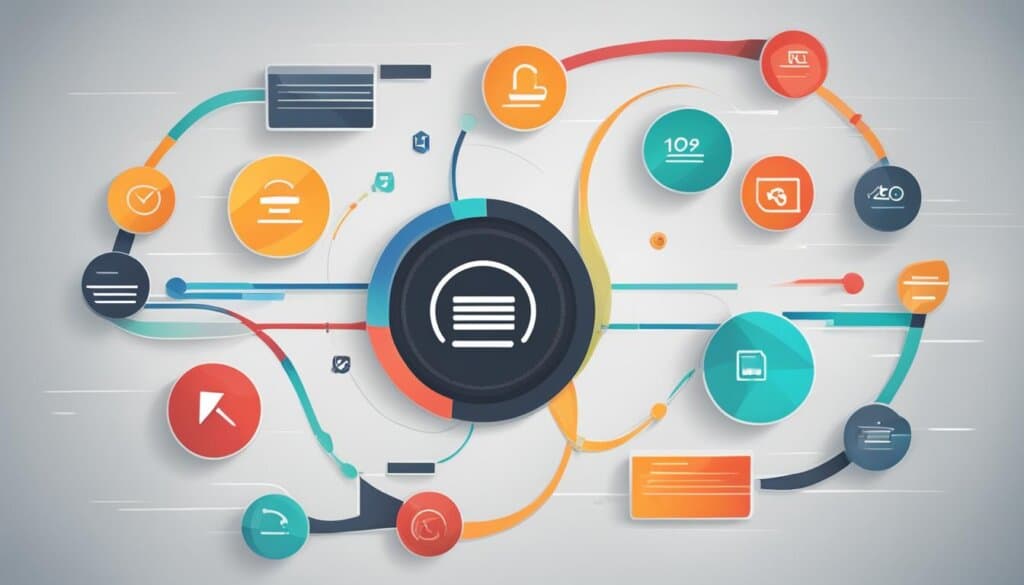Table of Contents
A feedback loop is a significant aspect of maintaining control and driving continuous improvement in various systems, including customer experience, product development, and workplace culture. It involves obtaining feedback from customers or employees and utilizing that feedback to make necessary improvements or changes.
In a feedback loop, there are two types: positive and negative. Positive feedback loops amplify a desired variable, while negative feedback loops help maintain balance. By understanding and leveraging the power of feedback loops, businesses can optimize their operations and create a more customer-centric environment.
How Does a Feedback Loop Work?
In a feedback loop, there are several crucial steps that help in capturing and utilizing customer feedback, leading to continuous improvement and enhanced customer experience. The steps in a feedback loop are as follows:
- Requesting or Receiving Feedback: This step involves actively seeking customer feedback through various channels such as surveys, reviews, or direct interactions.
- Gathering Information: Once customer feedback is received, it is important to gather and compile the information in a systematic manner. This helps in ensuring all feedback is considered for analysis and improvement purposes.
- Analysis: The next step is to analyze the feedback collected. This involves identifying recurring patterns, common themes, and areas of improvement or concern.
- Determining a Response: Based on the analysis, businesses need to determine the appropriate actions or responses to address the feedback received.
- Improving the Customer Experience: Once the response is determined, it is crucial to make the necessary improvements to enhance the customer experience and address any issues or concerns raised.
- Notifying Customers and Employees: Finally, it is essential to communicate the actions taken to customers and employees. This helps in closing the feedback loop and keeping all stakeholders informed about the improvements made.
Customer feedback plays a vital role in this process as it provides valuable insights into both positive and negative incidents and their causes. By leveraging customer feedback effectively, businesses can drive continuous improvement, foster customer loyalty, and ensure a customer-centric approach.
Customer Feedback: A Powerful Tool for Analysis and Improvement
Customer feedback is crucial for identifying one-time or ongoing positive or negative incidents and their causes.
Customer feedback serves as a powerful tool in the feedback loop process. It provides businesses with valuable insights into customer perceptions, preferences, and pain points. By analyzing and understanding customer feedback, businesses can uncover key areas for improvement and take proactive measures to enhance their products, services, and overall customer experience.
Through the analysis of customer feedback, businesses can identify trends, patterns, and common issues. This enables them to prioritize improvement efforts, address recurring customer concerns, and make data-driven decisions. Additionally, customer feedback helps businesses identify opportunities for innovation and identify potential gaps in their offerings.
Furthermore, customer feedback allows businesses to measure customer satisfaction. By monitoring and analyzing feedback, businesses can track customer sentiment over time and gauge the impact of their improvement initiatives. This data-driven approach helps in aligning business strategies with customer needs and preferences, resulting in increased customer satisfaction and loyalty.
Overall, customer feedback analysis plays a critical role in converting customer insights into actionable steps for improvement. By leveraging this valuable resource, businesses can enhance their products, services, and customer experience to stay ahead of the competition and foster long-term customer relationships.
Why Are Feedback Loops Important?
Feedback loops play a vital role in the success of businesses. By actively gathering and utilizing customer feedback, businesses can improve their products, services, and overall customer experience. This leads to enhanced offerings and the establishment of a customer-centric culture.
Customer feedback serves as a valuable source of information for businesses. It provides insights into the strengths and weaknesses of their products and services, allowing them to identify areas for improvement. Through feedback loops, businesses can gather specific feedback on various aspects, such as product features, usability, customer support, and more.
The Benefits of Customer Feedback
- Product Improvement: Customer feedback helps in identifying potential issues, bugs, or areas where products can be enhanced. By actively addressing customer feedback, businesses can make necessary improvements, resulting in better products and services.
- Enhancing Customer Experience: By listening to customer feedback, businesses can gain valuable insights into the customer journey and identify pain points or areas where the customer experience can be optimized. This enables businesses to tailor their offerings to better meet customer needs and expectations.
- Turning Insights Into Action: Feedback loops translate customer feedback into actionable steps for improvement. By analyzing feedback, businesses can identify trends and patterns, enabling them to make informed decisions and prioritize areas for enhancement.
Furthermore, feedback loops contribute to the development of a customer-centric culture within organizations. By valuing and actively seeking customer feedback, businesses demonstrate their commitment to customer satisfaction and continuous improvement. This fosters a culture where all employees are aligned with customer needs and are driven to deliver exceptional products and services.
Negative Feedback Loop Examples
Negative feedback loops provide valuable insights into areas where businesses can improve. By addressing these issues and making necessary changes, businesses can enhance customer satisfaction and improve their overall offering. Here are some examples of negative feedback loops:
Customer Service Issues
One common customer service issue is when customers experience long wait times or receive unhelpful responses from customer service representatives.
Product Faults or Bugs
Discovering frequent product faults or bugs can be detrimental to a business’s reputation. Customers may become frustrated when products do not meet their expectations or fail to function as intended.
Complicated Returns Process
Complex and lengthy returns processes can be a source of frustration for customers. When customers encounter difficulties in returning products, they may perceive the company as unresponsive or untrustworthy.
Website Usability
A poorly designed website with navigation issues or a confusing layout can discourage customers from making purchases. Difficulties in finding products or completing transactions may lead to a negative customer experience.
“We were excited to try out the new product, but the returns process was so complicated that we gave up and decided to keep it despite the faults.”
Addressing these negative feedback loop examples is crucial for businesses to rectify customer concerns, improve product quality, streamline processes, and enhance website usability. By proactively addressing these issues, businesses can create a positive customer experience and foster loyalty.
| Issue | Impact | Solution |
|---|---|---|
| Customer Service Issues | Decreased customer satisfaction | Implementing training programs for customer service representatives and improving response times |
| Product Faults or Bugs | Damage to brand reputation and customer trust | Conducting thorough quality assurance testing and implementing effective product bug resolution processes |
| Complicated Returns Process | Decreased customer loyalty and negative word of mouth | Simplifying returns procedures and providing clear instructions for customers |
| Website Usability | Decreased conversion rates and customer retention | Optimizing website navigation, improving search functionality, and ensuring a user-friendly interface |

Positive Feedback Loop Examples
Positive feedback loops play a crucial role in enhancing customer satisfaction and creating exceptional experiences. Here are some examples of positive feedback loops:
- Customer Appreciation for Excellent Customer Service: When customers receive outstanding support and assistance, they often express their gratitude through positive feedback. This appreciation for excellent customer service reinforces the importance of providing top-notch support and encourages businesses to continue delivering exceptional experiences to their customers.
- Product Solutions that Resolve Customer Issues: Another example of a positive feedback loop is when customers provide feedback about how a product has effectively addressed their needs or resolved key issues. This feedback validates the product’s value and encourages businesses to further enhance their offerings to meet customer expectations.
- Customers Expressing Loyalty and Satisfaction: Positive feedback loops also arise when customers express their love and satisfaction for a company’s service. These expressions of loyalty not only contribute to customer retention but also help in building a positive brand reputation. Happy customers often become brand ambassadors, recommending the company to others through word of mouth promotion.
Positive feedback loops are beneficial for businesses as they reinforce the significance of excellent customer service, validate product solutions, and foster customer appreciation. By leveraging these feedback loops, businesses can enhance customer retention, gain positive word of mouth promotion, and achieve overall customer happiness.
Image: An image of a customer service representative assisting a customer, highlighting the importance of excellent customer service in positive feedback loops.
Benefits of Feedback Loops
Feedback loops offer a range of benefits that contribute to the success of businesses. By utilizing customer feedback, organizations can drive product improvement and enhance overall customer satisfaction. This leads to improved customer retention and minimizes negative word of mouth. Additionally, feedback loops have a positive impact on workplace morale, boosting employee engagement and creating a harmonious work environment.
One of the key benefits of feedback loops is their ability to drive product improvement. By actively seeking and analyzing customer feedback, businesses can identify areas for enhancement and make necessary modifications to their products and services. This not only ensures that the products meet customer expectations but also helps organizations stay ahead of their competitors.
Closely linked to product improvement, feedback loops contribute significantly to customer retention. By addressing customer concerns and resolving issues promptly, businesses can demonstrate their commitment to customer satisfaction. By actively responding to feedback, organizations can minimize negative word of mouth and retain loyal customers. Satisfied customers are more likely to become brand advocates, helping to attract new customers and enhance the company’s reputation.
Furthermore, feedback loops boost workplace morale by involving employees in the improvement process. When employees see that their feedback is valued and directly contributes to positive changes, it creates a sense of ownership and empowerment. This boosts employee engagement and overall job satisfaction. When employees are motivated and satisfied, they are more willing to go the extra mile to provide exceptional customer service, which further contributes to customer retention and positive word of mouth.
In summary, feedback loops offer numerous benefits to businesses. They drive product improvement, enhance customer retention, minimize negative word of mouth, and boost workplace morale. Implementing effective feedback loops is crucial for organizations looking to stay competitive and provide exceptional customer experiences.
Positive and Negative Feedback Loop Definitions
In the world of business, a feedback loop is a powerful tool that allows organizations to harness the insights and inputs from their customers and employees for continuous improvement. It is a process where the outputs of a system serve as inputs for future operations, creating a dynamic cycle of feedback-driven growth. In this context, two types of feedback loops play a crucial role: negative feedback loops and positive feedback loops.
A negative feedback loop involves actively listening to customer feedback and using it to refine products or services. By addressing customer concerns and taking steps to rectify any shortcomings, businesses can enhance their offerings and ensure customer satisfaction. Through the implementation of effective negative feedback loops, organizations can maintain an optimal state, continuously improving and adapting to meet customer expectations.
On the other hand, a positive feedback loop focuses on enhancing workplace environments by listening to employees’ feedback and taking appropriate actions. By creating a culture that encourages open communication and valuing employee perspectives, organizations can improve work processes, boost morale, and drive innovation. Positive feedback loops amplify desired variables, fostering an environment where employees feel heard, valued, and empowered to contribute to the organization’s growth and success.
Both negative and positive feedback loops are essential for business success. Negative feedback loops help maintain balance, identify areas for improvement, and address customer concerns effectively. Positive feedback loops, on the other hand, foster a culture of continuous improvement, employee engagement, and innovation. By harnessing the power of feedback loops, organizations can cultivate improved customer satisfaction, employee happiness, and overall business performance.
FAQ
What is a feedback loop?
A feedback loop is the process of obtaining feedback from customers or employees and using that feedback to make improvements or changes.
How does a feedback loop work?
In a feedback loop, the steps usually involve requesting or receiving feedback, gathering information, analyzing the feedback, determining a response, improving the customer experience, and notifying customers and employees of the actions taken.
Why are feedback loops important?
Feedback loops are important because they allow businesses to gather feedback from their customers, who are the best source of information about their products and services. By actively addressing customer feedback and making improvements, businesses can enhance their offerings and create a customer-centric culture.
What are some examples of negative feedback loops?
Examples of negative feedback loops include customer dissatisfaction with customer service, frequently found product faults or bugs, complicated returns processes, and difficulties in finding products on a website.
What are some examples of positive feedback loops?
Examples of positive feedback loops include positive customer feedback on excellent customer service, feedback about how products have resolved key customer issues, and customers expressing their love for a company’s service.
What are the benefits of feedback loops?
Feedback loops have several benefits for businesses. They help in product and service improvement by using customer feedback to identify areas for enhancement. Feedback loops contribute to customer retention by addressing issues and improving customer satisfaction. They also help minimize negative word of mouth by resolving problems quickly and showing customers that their concerns are taken seriously. Additionally, feedback loops boost workplace morale by involving employees in the improvement process and creating a positive work environment.
What are negative and positive feedback loops?
A negative feedback loop involves listening to customer feedback to improve products or services, while a positive feedback loop involves listening to employees’ feedback to improve the workplace. Negative feedback loops are self-regulating and help maintain an optimal state, while positive feedback loops amplify desired variables.







